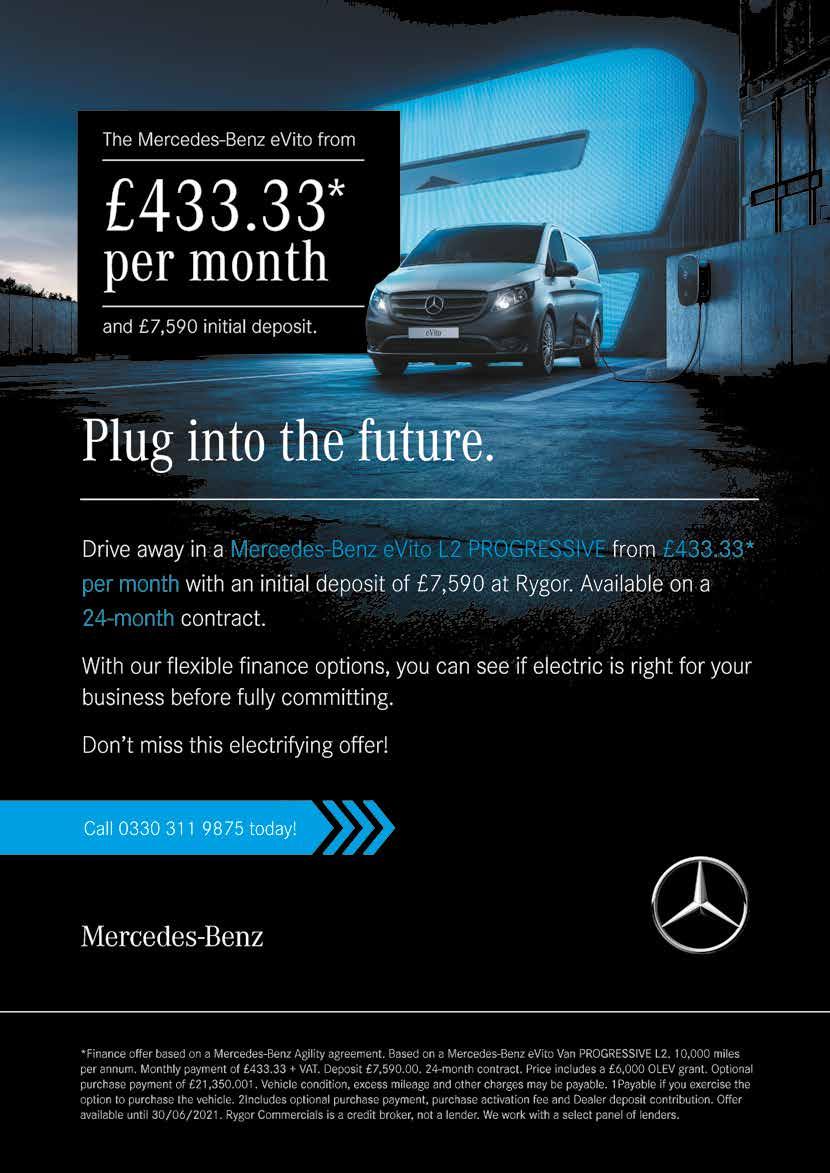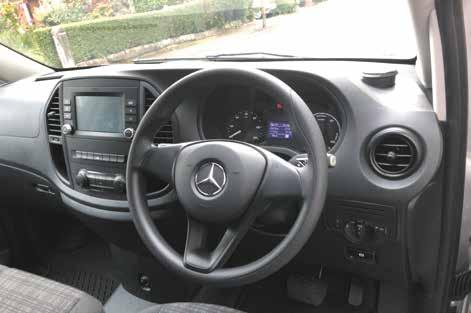
8 minute read
Mercedes e-Vito
Rock-solid eVito delivers the goods for city businesses
Andrew Walker relaxes in the comforting arms of Mercedes-Benz’s eVito
Advertisement
One of the first new electric vans to enter the fray was the MercedesBenz eVito, which arrived last summer. The entire range had been facelifted in 2019 and the eVito included all of the updates from the previous version.
The electric eVito offers 85 (70) kW of power, 300 Nm of torque, a 91-mile average range and a six-hour charging time. This is based on three-phase charging, which is lucky, because CC&V uses a 7kW Rolec home charger, so we could really find out if this charging time was true.
To keep things simple, the front-wheel drive eVito has been aligned with the current Vito range and offers a standard specification that mirrors the Pure model. Specification includes a height and rake adjustable steering wheel, Hill Start Assist, electrically adjustable heated exterior mirrors, sliding doors on both sides of the vehicle, wood flooring and an adaptive brake light. In addition, the eVito exclusively offers Mercedes PRO connect, which adds a heated driver’s seat, Tempmatic air conditioning, a four-metre charging cable, with a CanTrack vehicle tracker.
The eVito is offered in two lengths, L2 or L3. Prices start from £39,895 ex VAT for the eVito Van Pure L2, increasing to £40,415 ex VAT for the eVito Van Pure L3. And currently, Home Fast Smart charge point and installation worth £549 is included with eVito purchases.
As far as storage goes, the L2 model offers 6.0 m3 cargo volume, 2,277 kg kerb weight, 3,200 kg GVW, with a payload of 923 kg. The L3 offers 6.6 m3 cargo volume, 2,302 kg kerb weight, 3,200 kg GVW and a payload of 898 kg.
If you want a bit more on your van, then you can always opt for the eVito Progressive. This adds colour-coded bumpers, full wheel covers, front fog lights, Headlight Assist, a 75mph speed limiter, Audio 15, lumbar support and electrically foldable mirrors. The eVito Progressive van L2 costs from £41,600 ex VAT and £42,120 ex VAT for the L3 variant.
For both specification levels, Mercedes PRO connect, which we first experienced in the new Sprinter, comes as standard and it’s free for the first three years. Benefits for driver and fleet manager include Remote Access, Digital Drivers’ Log, Drive Style monitoring, real-time variable servicing monitoring, parking time monitor and geo-fence options. As an electric van, the eVito benefits from pre-conditioning of the heaters and highlights the vehicle charging options nearby.
So far so good, but what’s the eVito like to drive and what’s it’s real range? Well, from the outside it looks just like a standard Vito. We were testing the entry level Pure L2 and you’d be hard-pressed to know it’s an electric van unless you get up close and read the discreet eVito and eLECTRIC badging. Even the fuel cap is in the same place on the left hand side of the van.
Inside, all seems familiar. You get the 2019 updated Vito interior, which includes two USBs and a heated front driver seat, but not proper AirCon. It was 30 degrees the week I drove the eVito and although AirCon will drain the battery, I was forced to drive with the windows open just to keep vaguely cool.
There’s a three-seat configuration up front, as well as some top-of-the-dash storage, a decent glove box and two handy deep door pockets, but not anywhere to fit a large bottle or drinks container. The ignition is on the left.
Continued on page 40

Continued from page 38
Power steering is standard and the wheel is both rake and reach adjustable. The driver’s seat also offers a myriad of adjustment, so getting comfortable was not a problem. The handbrake is located on the floor as it is in Mercedes cars. You push a ‘fourth’ pedal with your left foot to engage the brake and then pull a dash mounted lever to release. I found it straightforward to use, although some may not like it as it doesn’t help you with hill starts.
In the centre of the dash and higher up than in some vans are the infotainment system and heating controls. The infotainment screen is slightly awkward to reach for the driver, as is the USB inputs which are on the left of the dash. For a left-hand drive Vito this location would make perfect sense.
The front windows are electric and keeping the cabin quiet is a full width bulkhead. The quality is top-notch but it’s not as practical a cab as some competitors.
The rear load space is easily accessed as the L2 Vito we drove comes with left and right hand slide-opening side doors and twin rear doors that open 180 degrees. To be fair we used it only once, to transport a mountain bike into the Peak District and it was a simple enough task to fix the bike to the hooks located in the rear floorspace, to stop it moving around.
Of more interest, I’m sure, is how the eVito
drives and how far one can travel in it. For starters it’s easy to drive and very relaxing on the motorway. The gear lever offers Neutral, Reverse or Drive options and even with the battery weight underneath the floor, the eVito handles pretty well for it’s weight.
As with most electric cars, the eVito offers several levels of regenerative braking, which can be adjusted using the paddles on either side of the steering wheel. This enables you in traffic or in town, to utilise D-, the strongest regenerative level, which is also the most noticeable. You can then decrease the strength of regeneration by pulling on the right hand paddle, moving through the options of D, then D+ and as we found for motorway driving the very useful D++.
When driving the eVito, you can choose from three drive modes: E+, E or C. There is a dash-mounted button in the centre console to select these. E+ offers the most efficient driving style; E is the middle option and the one we preferred or you can select C, which is the least efficient – but the most fun.
The eVito was delivered with a full charge, offering a 91-mile range. We drove to Chester in drive mode E along the M56 at around 70mph, a total distance of 30 miles. On arrival at Tesco, we took advantage of the Podpoint charger while we shopped, which allowed us up to two hours of free charging. You can access these via the Podpoint App. Our journey had decreased the range from 91 miles to 55 and after an hour charging was back up to 71 miles for the return leg. Thirty miles later and back home, the range now showed 36 miles.
We then repeated the identical journey the following day and concluded that if driven unladen with just a driver, at mostly motorway speeds, then the eVito offers an 80-mile range. For the remainder of our week we drove locally and once up into the Peaks and back, at lower speeds of up to 50mph. At these speeds as we found, the range is a genuine 90 miles, as you can really take advantage of the regenerative braking to keep that battery topped up.
This may sound like damning with faint praise, but when we have driven other electric cars or vans they are regularly no better than 70-80 per cent accurate on their electric range, so the eVito, at 88 per cent or better on our test, was a pleasant surprise.
In comparison to other similar sized electric vans, such as the PSA Group’s Viavro-e, e-Dispatch and e-Expert, the 91-mile range of the eVito can’t match PSA’s claimed WLTP battery range of 143 miles. We’d be surprised though, if the real range is more than 110 miles
Should my business get one? If you have a van that only travels locally at 75 miles or under per day, then it’s well worth a look. It’s not as cheap as the diesel Vito, whose entry level model costs £23,900 + VAT. In comparison our test eVito retails at £39,895 – though it is higher specced. That’s a big difference. The OLEV grant does claw some of this back, but the main saving will be on fuel. We reckon that in a calendar year and driving 10,000 miles in your eVito, you’ll save 75 per cent on your fuel costs by plugging in rather than filling with diesel.
In conclusion, the eVito was much better than we expected. It performed well above average on our EV mileage range tests, it’s comfortable, quiet to drive and now offers Apple CarPlay or Android Auto, something we really can’t live without.
On the negative side, we really would have liked proper air conditioning, in lieu of the heated driver’s seat perhaps, and cruise control would have been handy too, as we found the accelerator pedal quite heavy going on the motorway.


CC&V VERDICT
Rock solid performer. Plenty of businesses don’t need a complete fleet of long-distance diesel vans. If your business has charging stations, or you have one at home, there really is nothing to fear from an electric Vito. An eVito Corleone of a van
CC&V RATING:
N N N N











